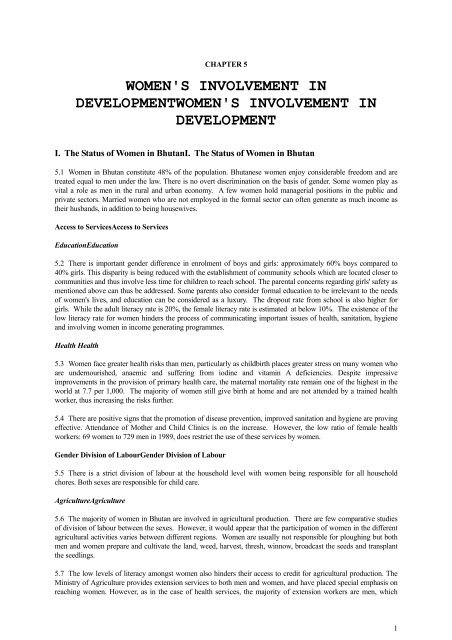COUNTRY BACKGROUND - Gross National Happiness Commission
COUNTRY BACKGROUND - Gross National Happiness Commission
COUNTRY BACKGROUND - Gross National Happiness Commission
Create successful ePaper yourself
Turn your PDF publications into a flip-book with our unique Google optimized e-Paper software.
CHAPTER 5<br />
WOMEN'S INVOLVEMENT IN<br />
DEVELOPMENTWOMEN'S INVOLVEMENT IN<br />
DEVELOPMENT<br />
I. The Status of Women in BhutanI. The Status of Women in Bhutan<br />
5.1 Women in Bhutan constitute 48% of the population. Bhutanese women enjoy considerable freedom and are<br />
treated equal to men under the law. There is no overt discrimination on the basis of gender. Some women play as<br />
vital a role as men in the rural and urban economy. A few women hold managerial positions in the public and<br />
private sectors. Married women who are not employed in the formal sector can often generate as much income as<br />
their husbands, in addition to being housewives.<br />
Access to ServicesAccess to Services<br />
EducationEducation<br />
5.2 There is important gender difference in enrolment of boys and girls: approximately 60% boys compared to<br />
40% girls. This disparity is being reduced with the establishment of community schools which are located closer to<br />
communities and thus involve less time for children to reach school. The parental concerns regarding girls' safety as<br />
mentioned above can thus be addressed. Some parents also consider formal education to be irrelevant to the needs<br />
of women's lives, and education can be considered as a luxury. The dropout rate from school is also higher for<br />
girls. While the adult literacy rate is 20%, the female literacy rate is estimated at below 10%. The existence of the<br />
low literacy rate for women hinders the process of communicating important issues of health, sanitation, hygiene<br />
and involving women in income generating programmes.<br />
Health Health<br />
5.3 Women face greater health risks than men, particularly as childbirth places greater stress on many women who<br />
are undernourished, anaemic and suffering from iodine and vitamin A deficiencies. Despite impressive<br />
improvements in the provision of primary health care, the maternal mortality rate remain one of the highest in the<br />
world at 7.7 per 1,000. The majority of women still give birth at home and are not attended by a trained health<br />
worker, thus increasing the risks further.<br />
5.4 There are positive signs that the promotion of disease prevention, improved sanitation and hygiene are proving<br />
effective. Attendance of Mother and Child Clinics is on the increase. However, the low ratio of female health<br />
workers: 69 women to 729 men in 1989, does restrict the use of these services by women.<br />
Gender Division of LabourGender Division of Labour<br />
5.5 There is a strict division of labour at the household level with women being responsible for all household<br />
chores. Both sexes are responsible for child care.<br />
AgricultureAgriculture<br />
5.6 The majority of women in Bhutan are involved in agricultural production. There are few comparative studies<br />
of division of labour between the sexes. However, it would appear that the participation of women in the different<br />
agricultural activities varies between different regions. Women are usually not responsible for ploughing but both<br />
men and women prepare and cultivate the land, weed, harvest, thresh, winnow, broadcast the seeds and transplant<br />
the seedlings.<br />
5.7 The low levels of literacy amongst women also hinders their access to credit for agricultural production. The<br />
Ministry of Agriculture provides extension services to both men and women, and have placed special emphasis on<br />
reaching women. However, as in the case of health services, the majority of extension workers are men, which<br />
1

















